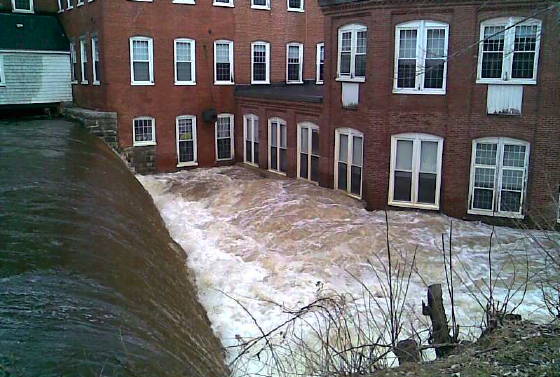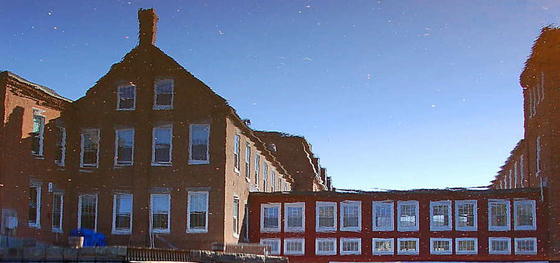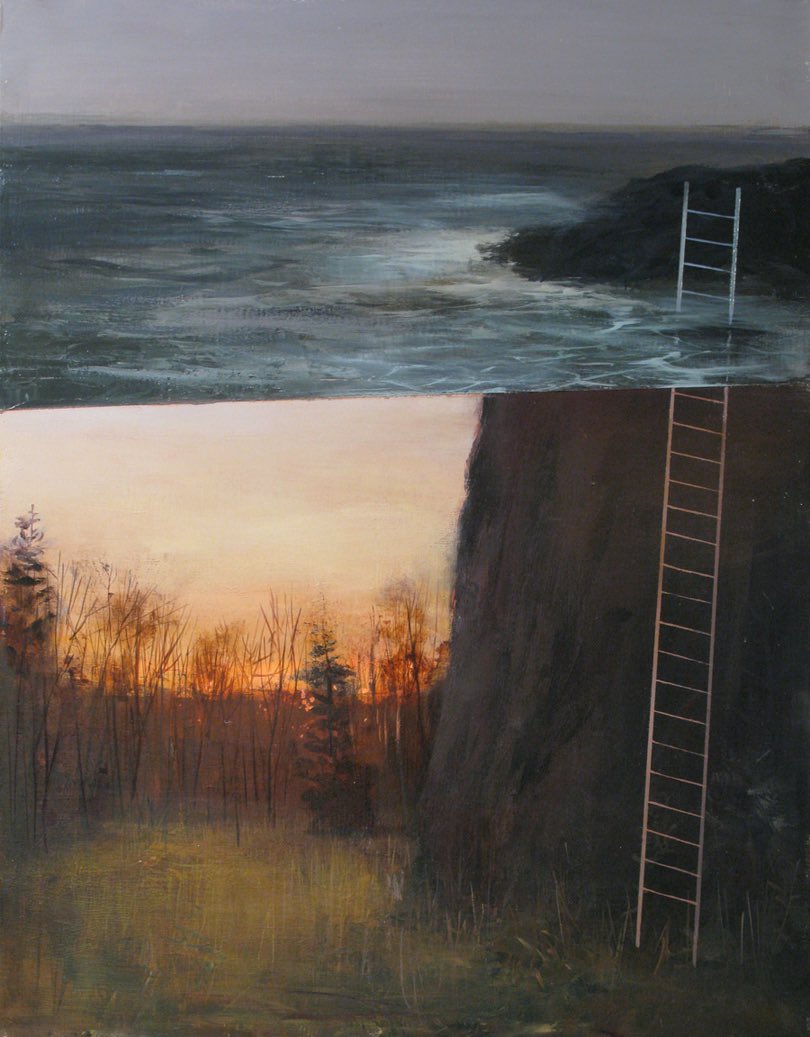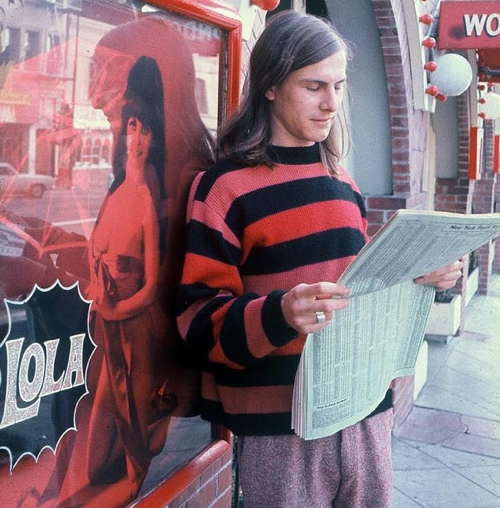Upstream they’ve allowed the water level of the river to fall until the dam’s top blocks can be seen as the waterfall retreats. The river’s bottom emerges and a spring shorebird skitters along the edge of the green muck, its beak probing the dirt. Three pigeons pace on and peck at the drying granite blocks. Each block in the slightly curved dam wall under their feet is an easy ton of stone. The dam spans the river and, when the water is allowed to rise, it vanishes under a sheen of falling water. But now the water is low even though the river still flows.
Behind the dam, a grating of steel bars lets the river flow under the dam and gush out the spill pipe at the foot of the stone blocks. There the river continues to flow under the footbridge, between the stone and brick walls of the mill, over another waterfall further on, and then, past other mills still downstream, out to sea.
The mill holds the river tight between its walls for a short span and, in the past, the dipping, turning wheels would have spun drawing the river’s power into the mill and, through rods and pulleys, relayed it on to the machines.
The first mill at this turn of the river was a sawmill in 1649. Then a grist mill came in its place. In time that too was torn down and the granite and brick buildings here now were raised up. The mill rises above the river, five stories of brick set on many courses of granite foundation stones. In its current form, the mill made fabrics from civil war uniforms to fine cashmere. Another mill just downstream made munitions for our arsenals. One gun from those foundries and lathes went first north to Portland and later west out over the ocean to Pearl Harbor. Later that mill’s machines made other parts out of case-hardened steel and pig iron. Other products, over the years, came from the mill: Christmas tree ornaments, cameras and film, paint, ice creepers for the Russian troops during World War II, rifle grenades, ski poles, waterproof boxes, and wooden shoes.
Today those machines are gone. Today the mill houses those who admire the fashionability of loft-like apartments; who value the anonymity of its corridors and numbered doors.
On massive granite blocks, the mill as it now is has straddled the river for over a century. With care and maintenance, it’s good for another century — or two or three — even though its use then cannot be foreseen any more than the builders of the mill would have thought in their day that they were building housing.
The men who built the mill built better than they knew; far better than the Frank Lloyd Wright fancy “Falling Water,” once lauded by all but now already being rotted out and reclaimed by the stream it enfolded. The mill was not built as a fancy but as a machine for making and now a machine for living, built to last by men whom we cannot hope to emulate.
In full spate, the river surges between the mill’s walls and, at times, rises to flood the lowest apartments much to the distress of its fashionable tenants.

At flood speed, the river rushes beneath the lower windows with a rumble and a stifled roar as if some endless ghost freight train was passing, passing, passing.
But then the spring flood abates to the hushed rustle and hum of flow. Over the calmer water barn swallows daub their nests under the eaves and, at dusk, dart and flicker over the water. And the mill around them, built long ago on the rocks of capital, skill, muscle, sinew, and faith, contains the river below with the spring sky seen in its surface. The mill, raised on granite and formed from fire-forged bricks laid one after the other by arm and hand, mortar and trowel, built to last, endures.
Today we live in the reflection of their times. Today we taste the afterimage of events.











 Gerard Van der Leun
Gerard Van der Leun
























Comments on this entry are closed.
I’ve seen this essay before, here I imagine. Great read&fotos.
I an reminded of an article in the second Whole Earth Catalog that described products and services of the James Leffel Company of Cincinatti, makers of hydroelectric generators. Among their product line they offered a small one, suitable for individual farms, etc, which is what caught my interest.
Fast forward about forty years and I wondered whatever became of the company, searched for it, and tripped over an article.
A once-company town of the Ford Motor Company located in the adjacency of Ohio, Michigan, and Indiana was bringing their environs up to speed to feature its place in history and increase marketability. There was an old hydro plant, dormant and in disarray, that once fed the Ford factory and the town. It was decided to refurb the generating plant as a museum. The Leffel Company was contacted as, IIRC, they made the original installation. An assessment was made and it was decided that the plant could be restored, and actually brought back on line, which it was.
-as always, check my math.
Mill in Stafford CT currently purposed as a printed board manufacturing facility for TTM Technologies. They do some unique work for defense contractors. I have visited the facility many times over the last 25 years.
https://www.google.com/maps/@41.9849617,-72.2887003,3a,15y,286.8h,88.95t/data=!3m6!1e1!3m4!1sqAP4LsdQEaVIFiZ8pF2GbQ!2e0!7i13312!8i6656?hl=en&authuser=0
“…built to last by men whom we cannot hope to emulate.”
=========
You can, but you have to have the inflation dollars and the knowledge to do so.
Almost everybody will settle for “good enough” and for them it probably is.
But it won’t last.
That’s a photo of the Sawyer Mill Apartments here in Dover NH.
https://www.youtube.com/watch?v=Wsi9SVdEo5o
Yikes! Not what I’d like to see looking out the window! And even if you were up on the top floor, you’d have to wonder about the building’s foundations, especially given the subsonic RUMBLE you’d be feeling & hearing while the torrent was passing by….
You have to wonder about the future for those apartments. A nearby “creek”, near here, was well mannered for a century but development, storm drains, hard surfaces, etc have changed its personality after a rain. Instead of being fed by gentle drainage, a storm brings a surge that floods homes, roads and yards. If the drainage upstream from the mill and apartments is developed, the apartments may have a “humidity” problem. Modern engineering “fixes”, driven by cost, convenience, and politics, tend to be rather unpleasant looking.